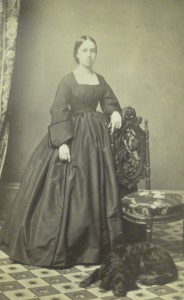 Dogs. Some people love them, others hate them. Regardless, there is just no getting around the fact that the lives of humans and dogs have long been intertwined. Depictions of dogs were painted on cave walls by early man and just last week images of “First Dog” Bo (the Obama’s Portuguese water dog) playing in Washington D.C.’s record snow fall were sent around the world via the Associated Press.
Dogs. Some people love them, others hate them. Regardless, there is just no getting around the fact that the lives of humans and dogs have long been intertwined. Depictions of dogs were painted on cave walls by early man and just last week images of “First Dog” Bo (the Obama’s Portuguese water dog) playing in Washington D.C.’s record snow fall were sent around the world via the Associated Press.
This week, the city of New York hosts the 134th Westminster Dog Show, bringing together an international selection of canines and their breeders and handlers. Westminster started in 1877, just at the tail-end (sorry!) of the American Antiquarian Society’s collecting range. However, the presence of dogs in many pre-1877 graphic materials in our collection shows American interest in man’s best friend indisputably pre-dates the invention of the formal dog show.
Dogs have long held symbolic meaning in prints, representing fidelity in wedding or patriotic images, or showing cowardice with tail betw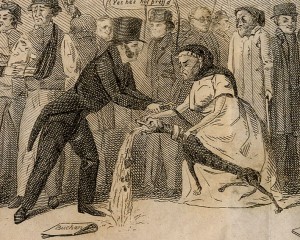 een the legs in political cartoons. Once you start looking for them, you see them everywhere. Dogs deficate, urinate and vomit in dozens of political cartoons and social sartires ( such as David Claypool Johnston’s Panacea Mania — detail at right). Capitalizing on the cuteness or hero factor,
een the legs in political cartoons. Once you start looking for them, you see them everywhere. Dogs deficate, urinate and vomit in dozens of political cartoons and social sartires ( such as David Claypool Johnston’s Panacea Mania — detail at right). Capitalizing on the cuteness or hero factor, 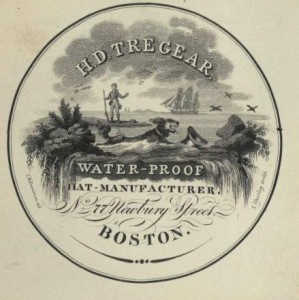 they also often appear in advertising material, helping American merchants sell everything from sewing needles to hats (see the trade card at left for Boston hatter H.D. Tregear where a dog bravely attempts to rescue his owner’s chapeau).
they also often appear in advertising material, helping American merchants sell everything from sewing needles to hats (see the trade card at left for Boston hatter H.D. Tregear where a dog bravely attempts to rescue his owner’s chapeau).
For this posting, however, we are looking at images of actual dogs, not the more common symbolic or fictional dogs. Therefore, for your viewing pleasure (or if you detest dogs – to your great dismay) and in honor of the biggest dog show in the world, we have selected a handful of photographs and drawings of actual pets from the Graphic Arts department, starting with a 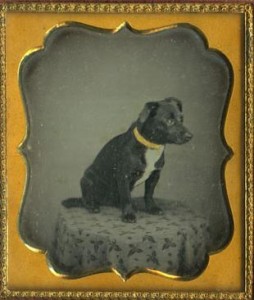 daguerreotype of Nero, a dog once owned by the Barton family. A mixed breed, Nero sits attentively on the photographer’s table, isolated from his human owners, but perhaps focused on them (or on a bit of chicken or liver like his counterparts in Madison Square Garden this week). Daguerreotype exposures could be lengthy, so the fact that Nero could hold the pose long enough to stay in focus is impressive. Additionally, the Bartons thought enough of the dog to pay extra to the photographer to have his collar hand-tinted with gold paint.
daguerreotype of Nero, a dog once owned by the Barton family. A mixed breed, Nero sits attentively on the photographer’s table, isolated from his human owners, but perhaps focused on them (or on a bit of chicken or liver like his counterparts in Madison Square Garden this week). Daguerreotype exposures could be lengthy, so the fact that Nero could hold the pose long enough to stay in focus is impressive. Additionally, the Bartons thought enough of the dog to pay extra to the photographer to have his collar hand-tinted with gold paint.
Carte-de-visite photographs became popular in the 1850s, and several in the Society’s large collection include dogs. A portrait by Boston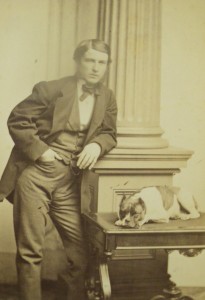 photographer John Adams Whipple of Henry H. Sturgis features a terrier mix resting atop a table while his owner leans casually against a pillar. Miss Anna Ball of Worcester took her setter to the studio of Charles Claflin and the dog slept on the floor while Anna posed in an elegant dress (image at top of post). Neither of these photographs include the name of the dog, although the Sturgis card has been annotated to include the name of the human sitter’s future wife (I wonder if she and the dog got along!).
photographer John Adams Whipple of Henry H. Sturgis features a terrier mix resting atop a table while his owner leans casually against a pillar. Miss Anna Ball of Worcester took her setter to the studio of Charles Claflin and the dog slept on the floor while Anna posed in an elegant dress (image at top of post). Neither of these photographs include the name of the dog, although the Sturgis card has been annotated to include the name of the human sitter’s future wife (I wonder if she and the dog got along!).
Drawings and paintings of specific pets are also found in the collection. The lithographers 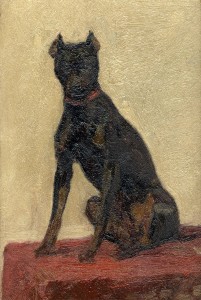 Louis Maurer and Charles Crehen as well as several members of the Johnston family often included dogs in their more generic hunting and farm scenes. In order to capture the dogginess of these fictional creatures, all of these artists made sketches of their own dogs which are now part of the AAS collection. Scattered across the Society’s drawing and artists collections, these images feature relaxed and tolerant beasts, all of which were probably used to being studied carefully by their owners.
Louis Maurer and Charles Crehen as well as several members of the Johnston family often included dogs in their more generic hunting and farm scenes. In order to capture the dogginess of these fictional creatures, all of these artists made sketches of their own dogs which are now part of the AAS collection. Scattered across the Society’s drawing and artists collections, these images feature relaxed and tolerant beasts, all of which were probably used to being studied carefully by their owners.
Bringing a pet to a photo studio or making a drawing may not tell us all that much about their specific owners (“Those Bartons, they must have been real dog people!”), but given the visual record, both practices were widespread. This does say something about Americans and their dogs. Historical examination of pets is being undertaken by numerous scholars (see Katherine Grier’s Pets in America, a History, University of North Caroline Press, 2006; or recent papers on animals and children presented by Brett Mizelle of California State University at Long Beach). We’ll let the scholars discuss the social and historical ramifications of owning a dog in America before 1877 – for now, we are happy to mark the opening of the 2010 Westminster Dog Show with this blog post. And in the interest of full disclosure: I’ll be rooting for the poodles but we also have strong feelings about pugs, springers, and greyhounds here in the Graphic Arts department. May the best dog win!
